The Role of Smartphones and Apps in the Learning Process: A Report
VerifiedAdded on 2020/03/02
|22
|5348
|381
Report
AI Summary
This research report examines the impact of smartphones and applications on the learning experiences of students in higher education, particularly within the field of information technology. It explores the use of smartphones for accessing information, facilitating communication between instructors and students, and enhancing collaboration. The report includes a literature review, analysis of findings, and discussion of the impact, limitations, and future scope of smartphone use in education. It also delves into the application of smartphone apps for project management and other learning activities, highlighting the potential for improved student engagement and access to resources. The study investigates the objectives of smartphone use in higher education, including the assessment of student experiences and preferences, and the identification of significant features for learning. The report concludes with a discussion of the benefits of m-learning, the role of smartphones in collaborative and individual learning, and the potential for personalized learning experiences.
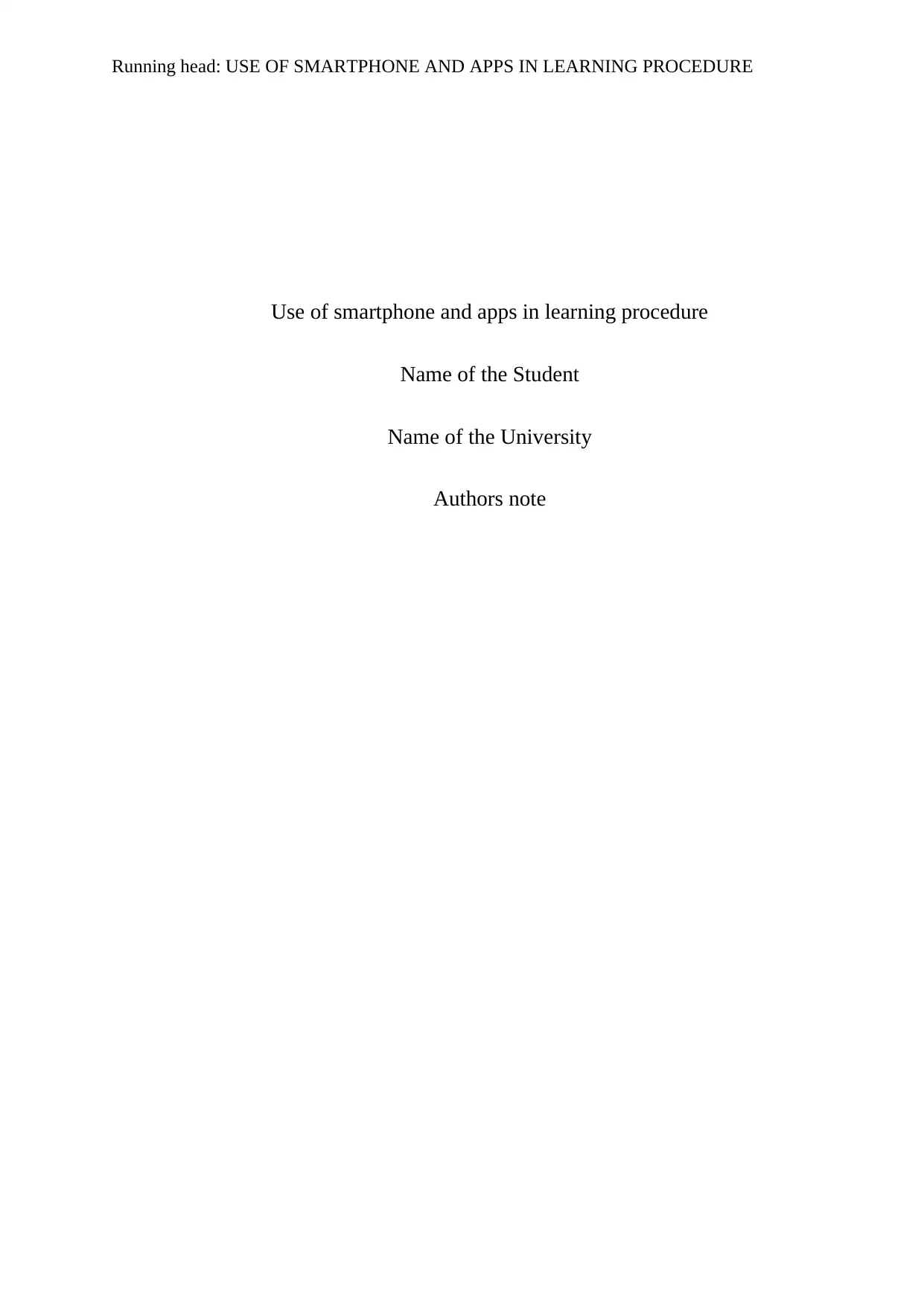
Running head: USE OF SMARTPHONE AND APPS IN LEARNING PROCEDURE
Use of smartphone and apps in learning procedure
Name of the Student
Name of the University
Authors note
Use of smartphone and apps in learning procedure
Name of the Student
Name of the University
Authors note
Paraphrase This Document
Need a fresh take? Get an instant paraphrase of this document with our AI Paraphraser
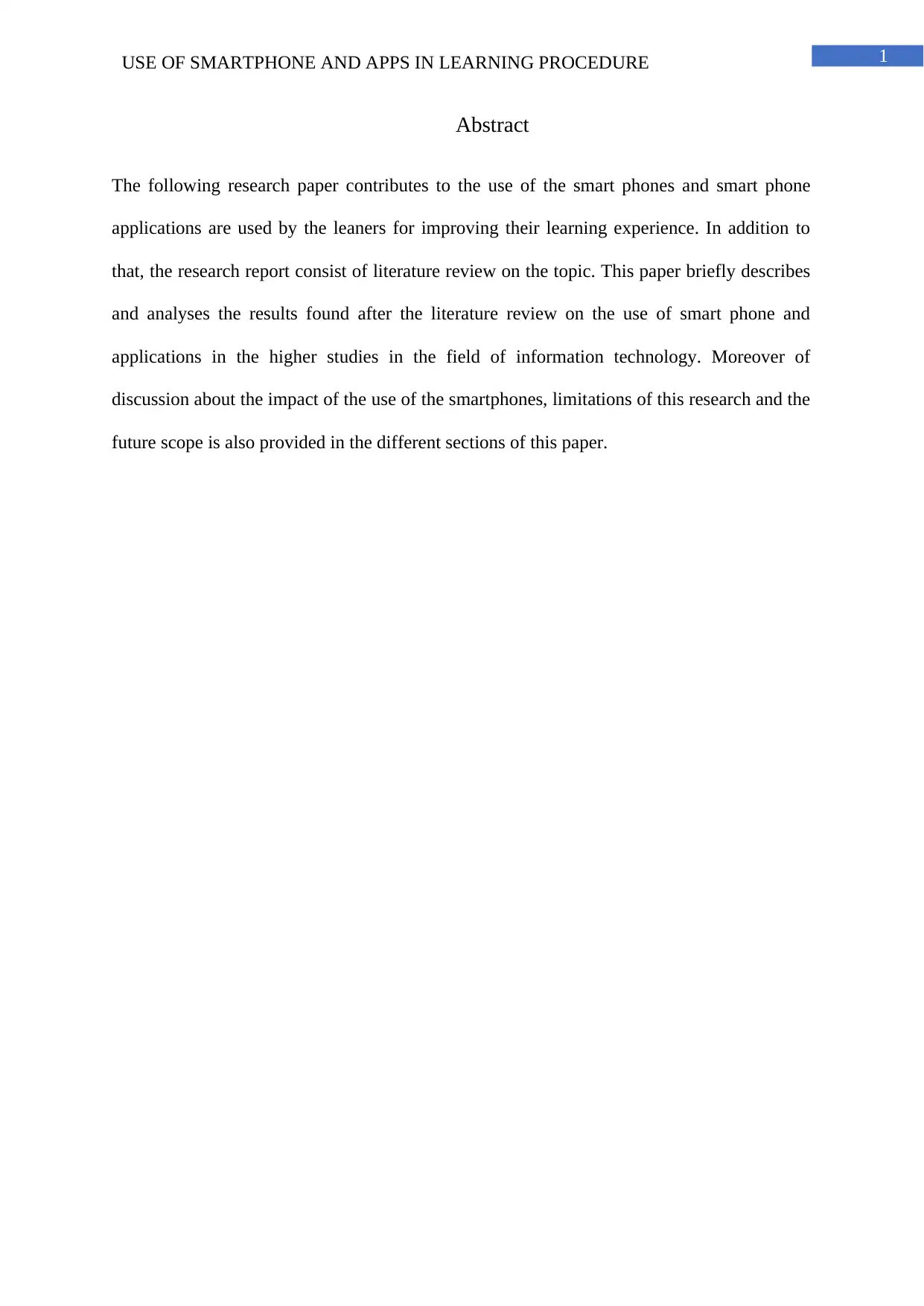
1USE OF SMARTPHONE AND APPS IN LEARNING PROCEDURE
Abstract
The following research paper contributes to the use of the smart phones and smart phone
applications are used by the leaners for improving their learning experience. In addition to
that, the research report consist of literature review on the topic. This paper briefly describes
and analyses the results found after the literature review on the use of smart phone and
applications in the higher studies in the field of information technology. Moreover of
discussion about the impact of the use of the smartphones, limitations of this research and the
future scope is also provided in the different sections of this paper.
Abstract
The following research paper contributes to the use of the smart phones and smart phone
applications are used by the leaners for improving their learning experience. In addition to
that, the research report consist of literature review on the topic. This paper briefly describes
and analyses the results found after the literature review on the use of smart phone and
applications in the higher studies in the field of information technology. Moreover of
discussion about the impact of the use of the smartphones, limitations of this research and the
future scope is also provided in the different sections of this paper.
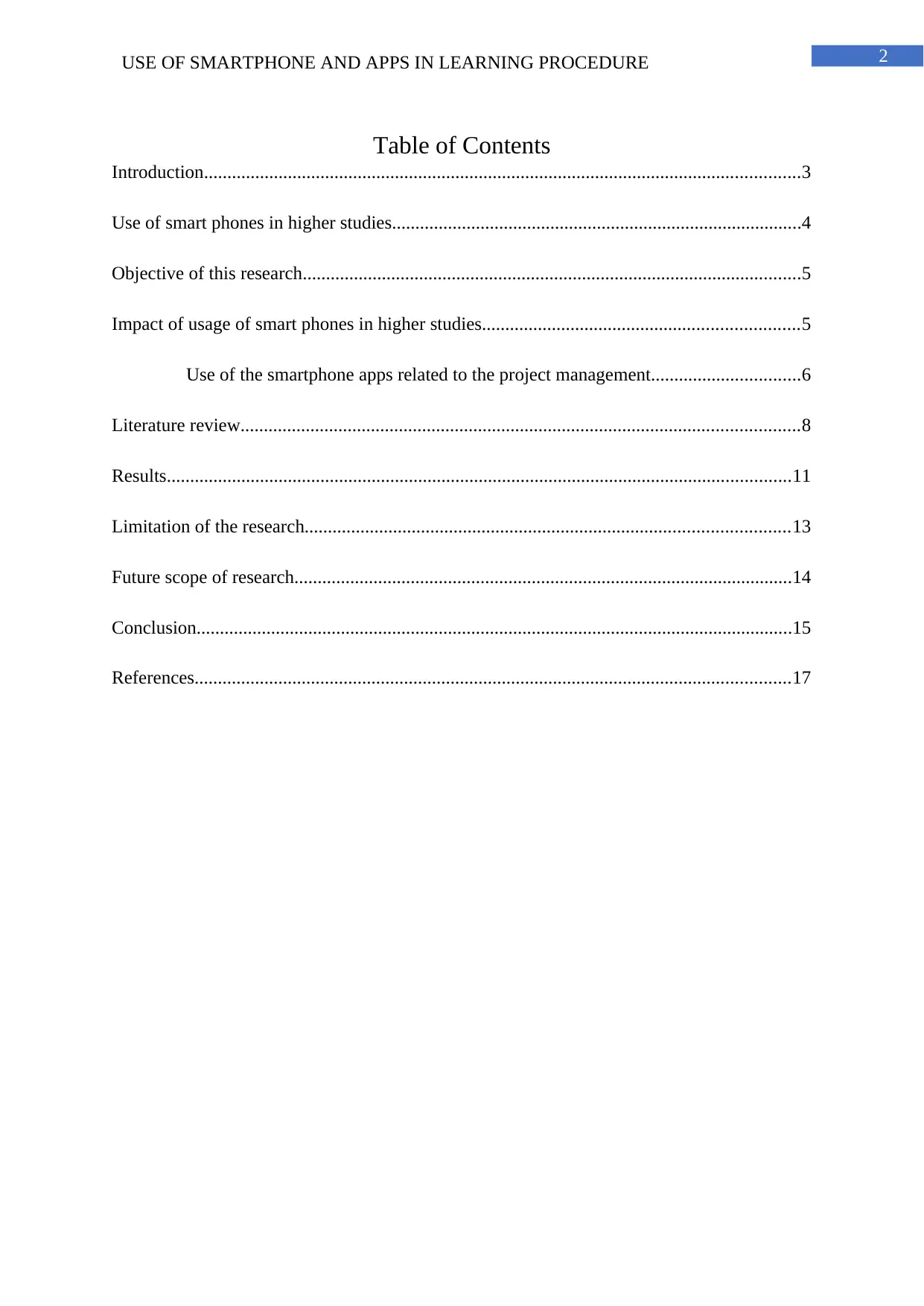
2USE OF SMARTPHONE AND APPS IN LEARNING PROCEDURE
Table of Contents
Introduction................................................................................................................................3
Use of smart phones in higher studies........................................................................................4
Objective of this research...........................................................................................................5
Impact of usage of smart phones in higher studies....................................................................5
Use of the smartphone apps related to the project management................................6
Literature review........................................................................................................................8
Results......................................................................................................................................11
Limitation of the research........................................................................................................13
Future scope of research...........................................................................................................14
Conclusion................................................................................................................................15
References................................................................................................................................17
Table of Contents
Introduction................................................................................................................................3
Use of smart phones in higher studies........................................................................................4
Objective of this research...........................................................................................................5
Impact of usage of smart phones in higher studies....................................................................5
Use of the smartphone apps related to the project management................................6
Literature review........................................................................................................................8
Results......................................................................................................................................11
Limitation of the research........................................................................................................13
Future scope of research...........................................................................................................14
Conclusion................................................................................................................................15
References................................................................................................................................17
⊘ This is a preview!⊘
Do you want full access?
Subscribe today to unlock all pages.

Trusted by 1+ million students worldwide
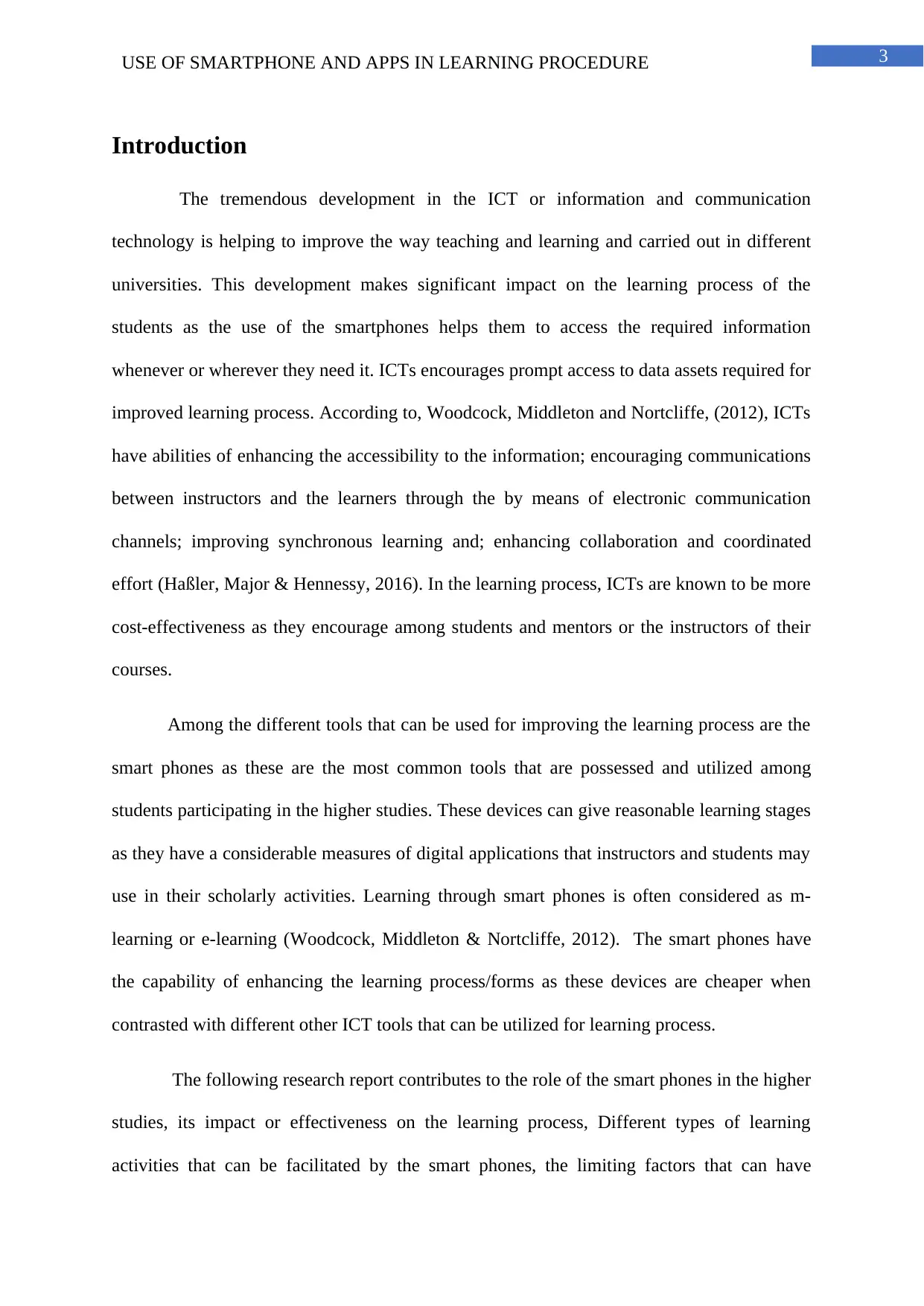
3USE OF SMARTPHONE AND APPS IN LEARNING PROCEDURE
Introduction
The tremendous development in the ICT or information and communication
technology is helping to improve the way teaching and learning and carried out in different
universities. This development makes significant impact on the learning process of the
students as the use of the smartphones helps them to access the required information
whenever or wherever they need it. ICTs encourages prompt access to data assets required for
improved learning process. According to, Woodcock, Middleton and Nortcliffe, (2012), ICTs
have abilities of enhancing the accessibility to the information; encouraging communications
between instructors and the learners through the by means of electronic communication
channels; improving synchronous learning and; enhancing collaboration and coordinated
effort (Haßler, Major & Hennessy, 2016). In the learning process, ICTs are known to be more
cost-effectiveness as they encourage among students and mentors or the instructors of their
courses.
Among the different tools that can be used for improving the learning process are the
smart phones as these are the most common tools that are possessed and utilized among
students participating in the higher studies. These devices can give reasonable learning stages
as they have a considerable measures of digital applications that instructors and students may
use in their scholarly activities. Learning through smart phones is often considered as m-
learning or e-learning (Woodcock, Middleton & Nortcliffe, 2012). The smart phones have
the capability of enhancing the learning process/forms as these devices are cheaper when
contrasted with different other ICT tools that can be utilized for learning process.
The following research report contributes to the role of the smart phones in the higher
studies, its impact or effectiveness on the learning process, Different types of learning
activities that can be facilitated by the smart phones, the limiting factors that can have
Introduction
The tremendous development in the ICT or information and communication
technology is helping to improve the way teaching and learning and carried out in different
universities. This development makes significant impact on the learning process of the
students as the use of the smartphones helps them to access the required information
whenever or wherever they need it. ICTs encourages prompt access to data assets required for
improved learning process. According to, Woodcock, Middleton and Nortcliffe, (2012), ICTs
have abilities of enhancing the accessibility to the information; encouraging communications
between instructors and the learners through the by means of electronic communication
channels; improving synchronous learning and; enhancing collaboration and coordinated
effort (Haßler, Major & Hennessy, 2016). In the learning process, ICTs are known to be more
cost-effectiveness as they encourage among students and mentors or the instructors of their
courses.
Among the different tools that can be used for improving the learning process are the
smart phones as these are the most common tools that are possessed and utilized among
students participating in the higher studies. These devices can give reasonable learning stages
as they have a considerable measures of digital applications that instructors and students may
use in their scholarly activities. Learning through smart phones is often considered as m-
learning or e-learning (Woodcock, Middleton & Nortcliffe, 2012). The smart phones have
the capability of enhancing the learning process/forms as these devices are cheaper when
contrasted with different other ICT tools that can be utilized for learning process.
The following research report contributes to the role of the smart phones in the higher
studies, its impact or effectiveness on the learning process, Different types of learning
activities that can be facilitated by the smart phones, the limiting factors that can have
Paraphrase This Document
Need a fresh take? Get an instant paraphrase of this document with our AI Paraphraser
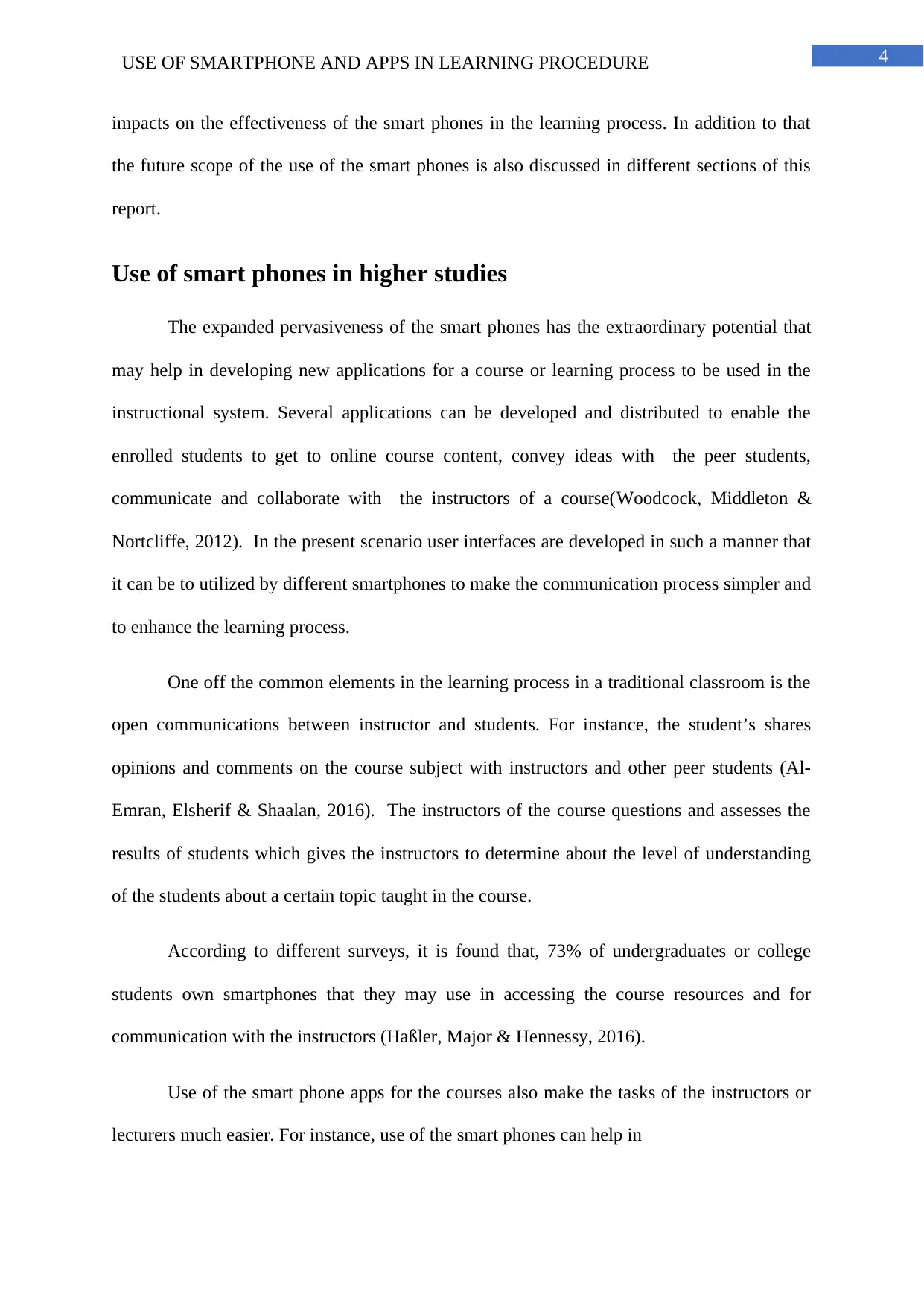
4USE OF SMARTPHONE AND APPS IN LEARNING PROCEDURE
impacts on the effectiveness of the smart phones in the learning process. In addition to that
the future scope of the use of the smart phones is also discussed in different sections of this
report.
Use of smart phones in higher studies
The expanded pervasiveness of the smart phones has the extraordinary potential that
may help in developing new applications for a course or learning process to be used in the
instructional system. Several applications can be developed and distributed to enable the
enrolled students to get to online course content, convey ideas with the peer students,
communicate and collaborate with the instructors of a course(Woodcock, Middleton &
Nortcliffe, 2012). In the present scenario user interfaces are developed in such a manner that
it can be to utilized by different smartphones to make the communication process simpler and
to enhance the learning process.
One off the common elements in the learning process in a traditional classroom is the
open communications between instructor and students. For instance, the student’s shares
opinions and comments on the course subject with instructors and other peer students (Al-
Emran, Elsherif & Shaalan, 2016). The instructors of the course questions and assesses the
results of students which gives the instructors to determine about the level of understanding
of the students about a certain topic taught in the course.
According to different surveys, it is found that, 73% of undergraduates or college
students own smartphones that they may use in accessing the course resources and for
communication with the instructors (Haßler, Major & Hennessy, 2016).
Use of the smart phone apps for the courses also make the tasks of the instructors or
lecturers much easier. For instance, use of the smart phones can help in
impacts on the effectiveness of the smart phones in the learning process. In addition to that
the future scope of the use of the smart phones is also discussed in different sections of this
report.
Use of smart phones in higher studies
The expanded pervasiveness of the smart phones has the extraordinary potential that
may help in developing new applications for a course or learning process to be used in the
instructional system. Several applications can be developed and distributed to enable the
enrolled students to get to online course content, convey ideas with the peer students,
communicate and collaborate with the instructors of a course(Woodcock, Middleton &
Nortcliffe, 2012). In the present scenario user interfaces are developed in such a manner that
it can be to utilized by different smartphones to make the communication process simpler and
to enhance the learning process.
One off the common elements in the learning process in a traditional classroom is the
open communications between instructor and students. For instance, the student’s shares
opinions and comments on the course subject with instructors and other peer students (Al-
Emran, Elsherif & Shaalan, 2016). The instructors of the course questions and assesses the
results of students which gives the instructors to determine about the level of understanding
of the students about a certain topic taught in the course.
According to different surveys, it is found that, 73% of undergraduates or college
students own smartphones that they may use in accessing the course resources and for
communication with the instructors (Haßler, Major & Hennessy, 2016).
Use of the smart phone apps for the courses also make the tasks of the instructors or
lecturers much easier. For instance, use of the smart phones can help in
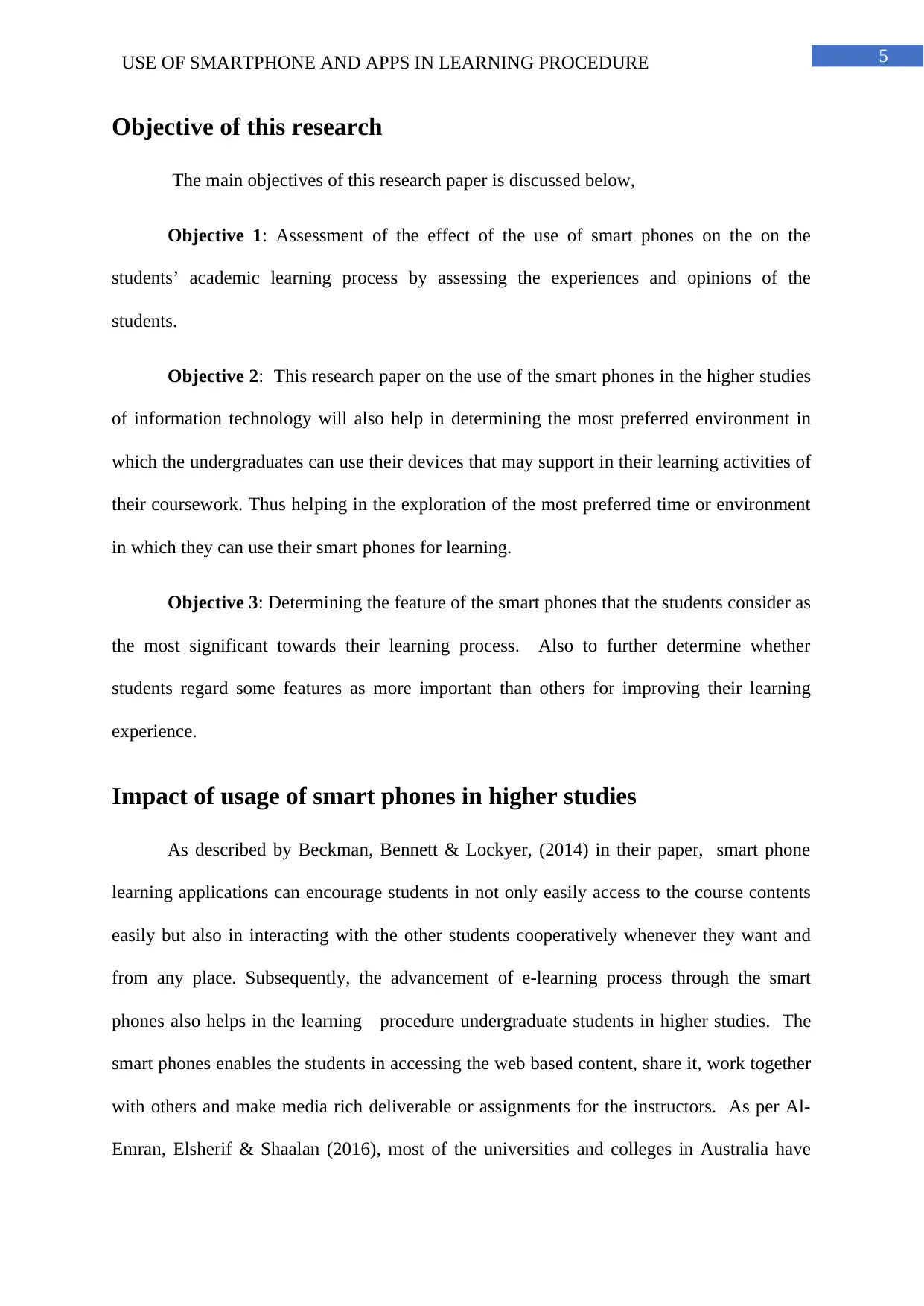
5USE OF SMARTPHONE AND APPS IN LEARNING PROCEDURE
Objective of this research
The main objectives of this research paper is discussed below,
Objective 1: Assessment of the effect of the use of smart phones on the on the
students’ academic learning process by assessing the experiences and opinions of the
students.
Objective 2: This research paper on the use of the smart phones in the higher studies
of information technology will also help in determining the most preferred environment in
which the undergraduates can use their devices that may support in their learning activities of
their coursework. Thus helping in the exploration of the most preferred time or environment
in which they can use their smart phones for learning.
Objective 3: Determining the feature of the smart phones that the students consider as
the most significant towards their learning process. Also to further determine whether
students regard some features as more important than others for improving their learning
experience.
Impact of usage of smart phones in higher studies
As described by Beckman, Bennett & Lockyer, (2014) in their paper, smart phone
learning applications can encourage students in not only easily access to the course contents
easily but also in interacting with the other students cooperatively whenever they want and
from any place. Subsequently, the advancement of e-learning process through the smart
phones also helps in the learning procedure undergraduate students in higher studies. The
smart phones enables the students in accessing the web based content, share it, work together
with others and make media rich deliverable or assignments for the instructors. As per Al-
Emran, Elsherif & Shaalan (2016), most of the universities and colleges in Australia have
Objective of this research
The main objectives of this research paper is discussed below,
Objective 1: Assessment of the effect of the use of smart phones on the on the
students’ academic learning process by assessing the experiences and opinions of the
students.
Objective 2: This research paper on the use of the smart phones in the higher studies
of information technology will also help in determining the most preferred environment in
which the undergraduates can use their devices that may support in their learning activities of
their coursework. Thus helping in the exploration of the most preferred time or environment
in which they can use their smart phones for learning.
Objective 3: Determining the feature of the smart phones that the students consider as
the most significant towards their learning process. Also to further determine whether
students regard some features as more important than others for improving their learning
experience.
Impact of usage of smart phones in higher studies
As described by Beckman, Bennett & Lockyer, (2014) in their paper, smart phone
learning applications can encourage students in not only easily access to the course contents
easily but also in interacting with the other students cooperatively whenever they want and
from any place. Subsequently, the advancement of e-learning process through the smart
phones also helps in the learning procedure undergraduate students in higher studies. The
smart phones enables the students in accessing the web based content, share it, work together
with others and make media rich deliverable or assignments for the instructors. As per Al-
Emran, Elsherif & Shaalan (2016), most of the universities and colleges in Australia have
⊘ This is a preview!⊘
Do you want full access?
Subscribe today to unlock all pages.

Trusted by 1+ million students worldwide
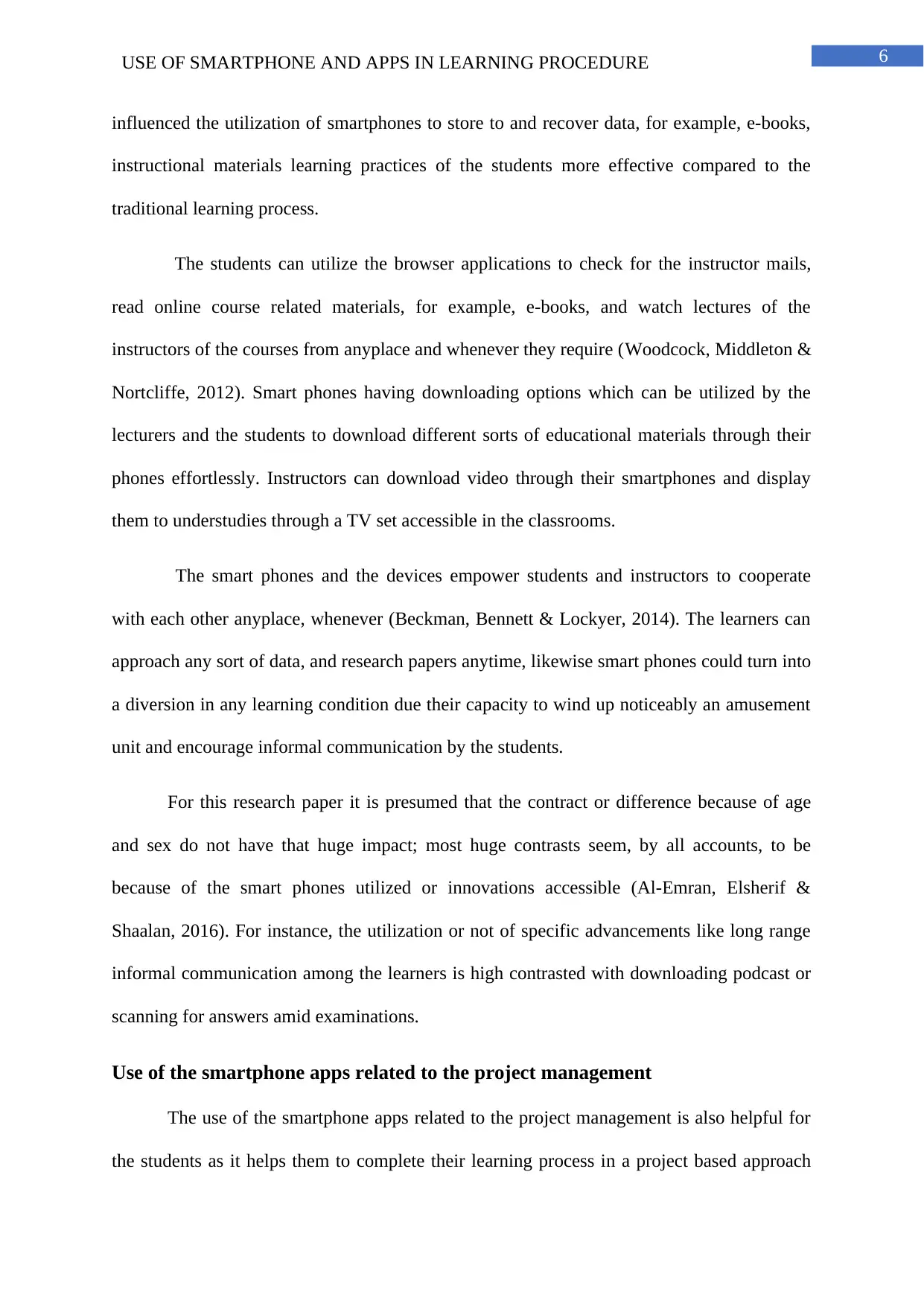
6USE OF SMARTPHONE AND APPS IN LEARNING PROCEDURE
influenced the utilization of smartphones to store to and recover data, for example, e-books,
instructional materials learning practices of the students more effective compared to the
traditional learning process.
The students can utilize the browser applications to check for the instructor mails,
read online course related materials, for example, e-books, and watch lectures of the
instructors of the courses from anyplace and whenever they require (Woodcock, Middleton &
Nortcliffe, 2012). Smart phones having downloading options which can be utilized by the
lecturers and the students to download different sorts of educational materials through their
phones effortlessly. Instructors can download video through their smartphones and display
them to understudies through a TV set accessible in the classrooms.
The smart phones and the devices empower students and instructors to cooperate
with each other anyplace, whenever (Beckman, Bennett & Lockyer, 2014). The learners can
approach any sort of data, and research papers anytime, likewise smart phones could turn into
a diversion in any learning condition due their capacity to wind up noticeably an amusement
unit and encourage informal communication by the students.
For this research paper it is presumed that the contract or difference because of age
and sex do not have that huge impact; most huge contrasts seem, by all accounts, to be
because of the smart phones utilized or innovations accessible (Al-Emran, Elsherif &
Shaalan, 2016). For instance, the utilization or not of specific advancements like long range
informal communication among the learners is high contrasted with downloading podcast or
scanning for answers amid examinations.
Use of the smartphone apps related to the project management
The use of the smartphone apps related to the project management is also helpful for
the students as it helps them to complete their learning process in a project based approach
influenced the utilization of smartphones to store to and recover data, for example, e-books,
instructional materials learning practices of the students more effective compared to the
traditional learning process.
The students can utilize the browser applications to check for the instructor mails,
read online course related materials, for example, e-books, and watch lectures of the
instructors of the courses from anyplace and whenever they require (Woodcock, Middleton &
Nortcliffe, 2012). Smart phones having downloading options which can be utilized by the
lecturers and the students to download different sorts of educational materials through their
phones effortlessly. Instructors can download video through their smartphones and display
them to understudies through a TV set accessible in the classrooms.
The smart phones and the devices empower students and instructors to cooperate
with each other anyplace, whenever (Beckman, Bennett & Lockyer, 2014). The learners can
approach any sort of data, and research papers anytime, likewise smart phones could turn into
a diversion in any learning condition due their capacity to wind up noticeably an amusement
unit and encourage informal communication by the students.
For this research paper it is presumed that the contract or difference because of age
and sex do not have that huge impact; most huge contrasts seem, by all accounts, to be
because of the smart phones utilized or innovations accessible (Al-Emran, Elsherif &
Shaalan, 2016). For instance, the utilization or not of specific advancements like long range
informal communication among the learners is high contrasted with downloading podcast or
scanning for answers amid examinations.
Use of the smartphone apps related to the project management
The use of the smartphone apps related to the project management is also helpful for
the students as it helps them to complete their learning process in a project based approach
Paraphrase This Document
Need a fresh take? Get an instant paraphrase of this document with our AI Paraphraser
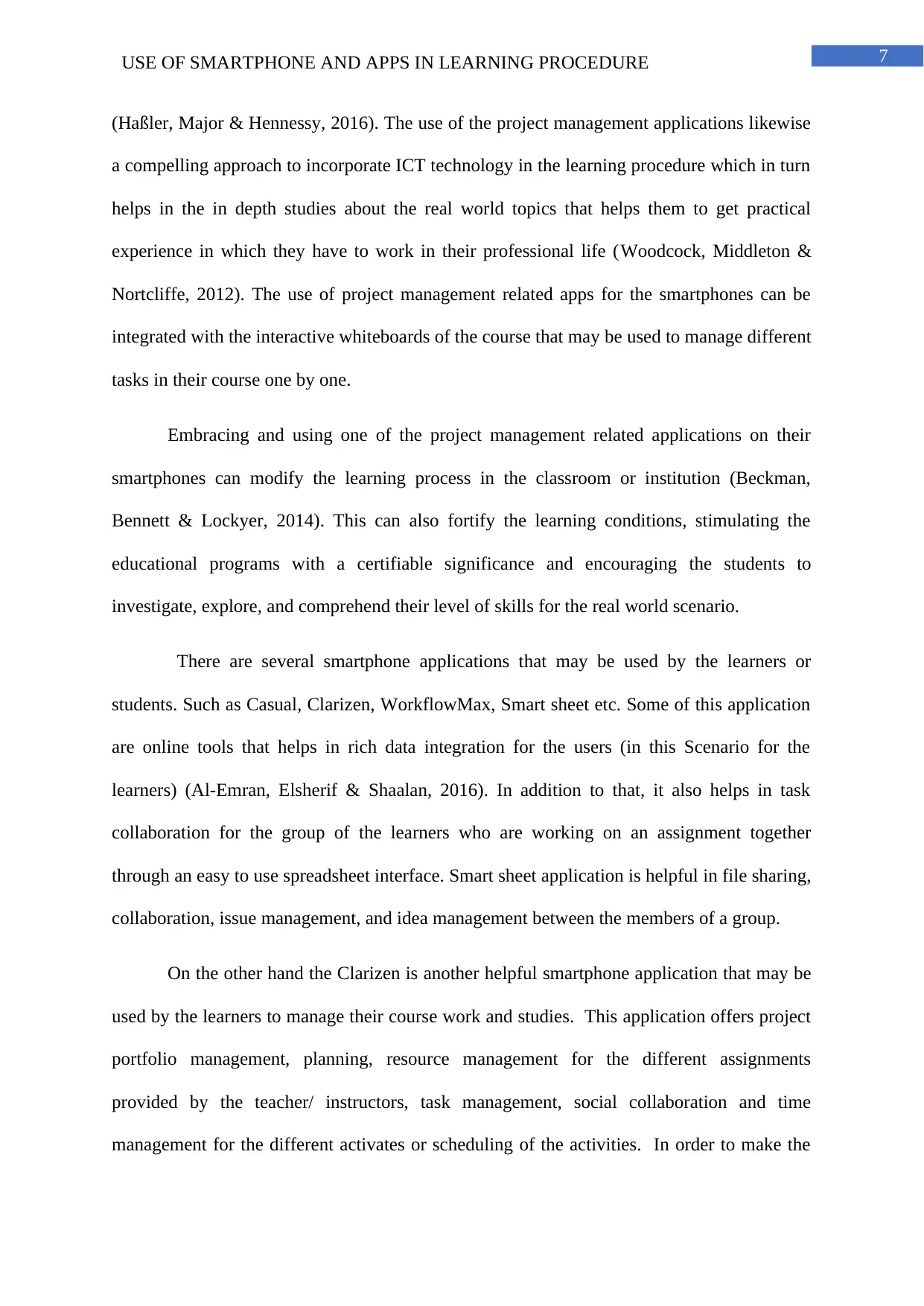
7USE OF SMARTPHONE AND APPS IN LEARNING PROCEDURE
(Haßler, Major & Hennessy, 2016). The use of the project management applications likewise
a compelling approach to incorporate ICT technology in the learning procedure which in turn
helps in the in depth studies about the real world topics that helps them to get practical
experience in which they have to work in their professional life (Woodcock, Middleton &
Nortcliffe, 2012). The use of project management related apps for the smartphones can be
integrated with the interactive whiteboards of the course that may be used to manage different
tasks in their course one by one.
Embracing and using one of the project management related applications on their
smartphones can modify the learning process in the classroom or institution (Beckman,
Bennett & Lockyer, 2014). This can also fortify the learning conditions, stimulating the
educational programs with a certifiable significance and encouraging the students to
investigate, explore, and comprehend their level of skills for the real world scenario.
There are several smartphone applications that may be used by the learners or
students. Such as Casual, Clarizen, WorkflowMax, Smart sheet etc. Some of this application
are online tools that helps in rich data integration for the users (in this Scenario for the
learners) (Al-Emran, Elsherif & Shaalan, 2016). In addition to that, it also helps in task
collaboration for the group of the learners who are working on an assignment together
through an easy to use spreadsheet interface. Smart sheet application is helpful in file sharing,
collaboration, issue management, and idea management between the members of a group.
On the other hand the Clarizen is another helpful smartphone application that may be
used by the learners to manage their course work and studies. This application offers project
portfolio management, planning, resource management for the different assignments
provided by the teacher/ instructors, task management, social collaboration and time
management for the different activates or scheduling of the activities. In order to make the
(Haßler, Major & Hennessy, 2016). The use of the project management applications likewise
a compelling approach to incorporate ICT technology in the learning procedure which in turn
helps in the in depth studies about the real world topics that helps them to get practical
experience in which they have to work in their professional life (Woodcock, Middleton &
Nortcliffe, 2012). The use of project management related apps for the smartphones can be
integrated with the interactive whiteboards of the course that may be used to manage different
tasks in their course one by one.
Embracing and using one of the project management related applications on their
smartphones can modify the learning process in the classroom or institution (Beckman,
Bennett & Lockyer, 2014). This can also fortify the learning conditions, stimulating the
educational programs with a certifiable significance and encouraging the students to
investigate, explore, and comprehend their level of skills for the real world scenario.
There are several smartphone applications that may be used by the learners or
students. Such as Casual, Clarizen, WorkflowMax, Smart sheet etc. Some of this application
are online tools that helps in rich data integration for the users (in this Scenario for the
learners) (Al-Emran, Elsherif & Shaalan, 2016). In addition to that, it also helps in task
collaboration for the group of the learners who are working on an assignment together
through an easy to use spreadsheet interface. Smart sheet application is helpful in file sharing,
collaboration, issue management, and idea management between the members of a group.
On the other hand the Clarizen is another helpful smartphone application that may be
used by the learners to manage their course work and studies. This application offers project
portfolio management, planning, resource management for the different assignments
provided by the teacher/ instructors, task management, social collaboration and time
management for the different activates or scheduling of the activities. In order to make the
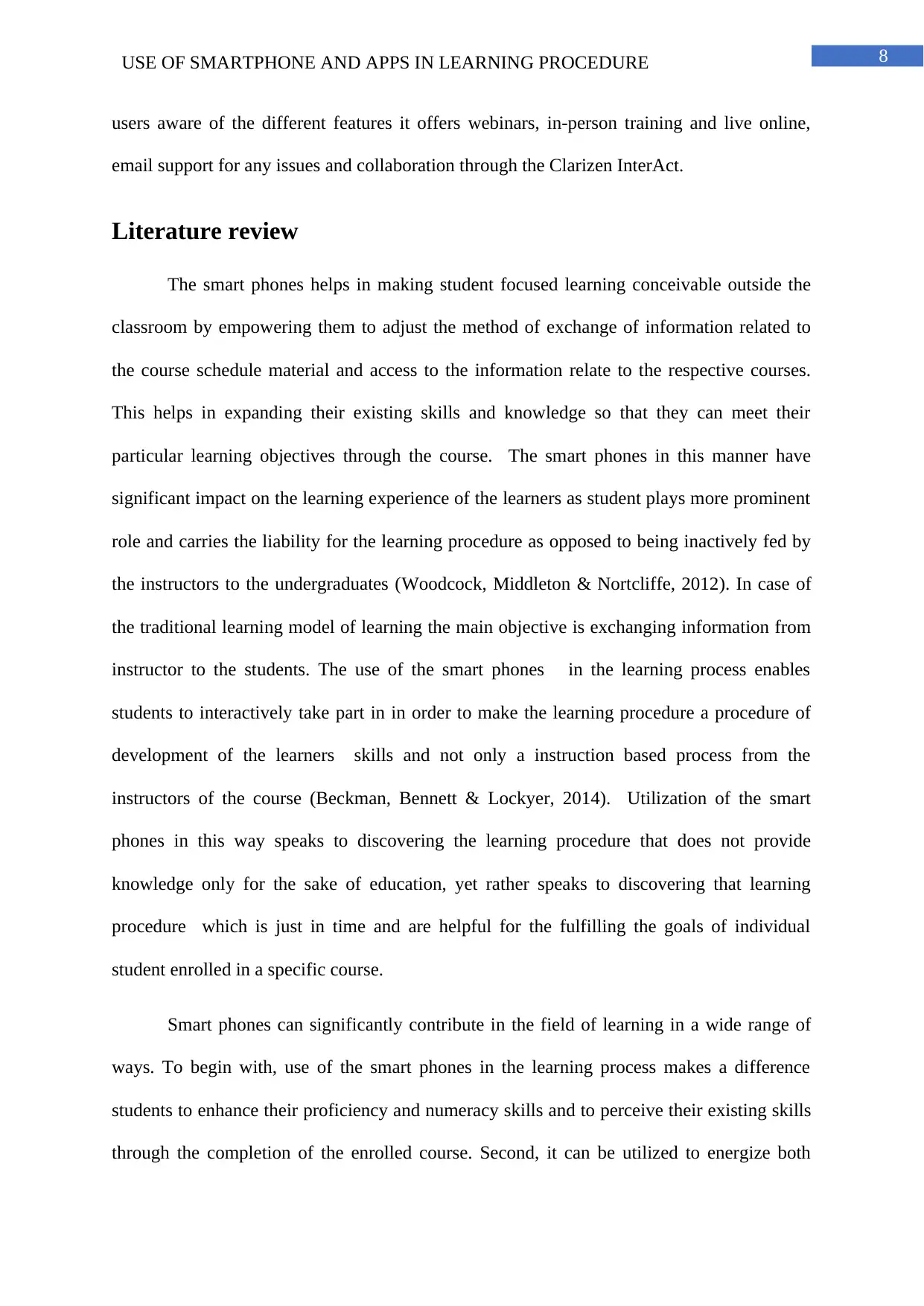
8USE OF SMARTPHONE AND APPS IN LEARNING PROCEDURE
users aware of the different features it offers webinars, in-person training and live online,
email support for any issues and collaboration through the Clarizen InterAct.
Literature review
The smart phones helps in making student focused learning conceivable outside the
classroom by empowering them to adjust the method of exchange of information related to
the course schedule material and access to the information relate to the respective courses.
This helps in expanding their existing skills and knowledge so that they can meet their
particular learning objectives through the course. The smart phones in this manner have
significant impact on the learning experience of the learners as student plays more prominent
role and carries the liability for the learning procedure as opposed to being inactively fed by
the instructors to the undergraduates (Woodcock, Middleton & Nortcliffe, 2012). In case of
the traditional learning model of learning the main objective is exchanging information from
instructor to the students. The use of the smart phones in the learning process enables
students to interactively take part in in order to make the learning procedure a procedure of
development of the learners skills and not only a instruction based process from the
instructors of the course (Beckman, Bennett & Lockyer, 2014). Utilization of the smart
phones in this way speaks to discovering the learning procedure that does not provide
knowledge only for the sake of education, yet rather speaks to discovering that learning
procedure which is just in time and are helpful for the fulfilling the goals of individual
student enrolled in a specific course.
Smart phones can significantly contribute in the field of learning in a wide range of
ways. To begin with, use of the smart phones in the learning process makes a difference
students to enhance their proficiency and numeracy skills and to perceive their existing skills
through the completion of the enrolled course. Second, it can be utilized to energize both
users aware of the different features it offers webinars, in-person training and live online,
email support for any issues and collaboration through the Clarizen InterAct.
Literature review
The smart phones helps in making student focused learning conceivable outside the
classroom by empowering them to adjust the method of exchange of information related to
the course schedule material and access to the information relate to the respective courses.
This helps in expanding their existing skills and knowledge so that they can meet their
particular learning objectives through the course. The smart phones in this manner have
significant impact on the learning experience of the learners as student plays more prominent
role and carries the liability for the learning procedure as opposed to being inactively fed by
the instructors to the undergraduates (Woodcock, Middleton & Nortcliffe, 2012). In case of
the traditional learning model of learning the main objective is exchanging information from
instructor to the students. The use of the smart phones in the learning process enables
students to interactively take part in in order to make the learning procedure a procedure of
development of the learners skills and not only a instruction based process from the
instructors of the course (Beckman, Bennett & Lockyer, 2014). Utilization of the smart
phones in this way speaks to discovering the learning procedure that does not provide
knowledge only for the sake of education, yet rather speaks to discovering that learning
procedure which is just in time and are helpful for the fulfilling the goals of individual
student enrolled in a specific course.
Smart phones can significantly contribute in the field of learning in a wide range of
ways. To begin with, use of the smart phones in the learning process makes a difference
students to enhance their proficiency and numeracy skills and to perceive their existing skills
through the completion of the enrolled course. Second, it can be utilized to energize both
⊘ This is a preview!⊘
Do you want full access?
Subscribe today to unlock all pages.

Trusted by 1+ million students worldwide
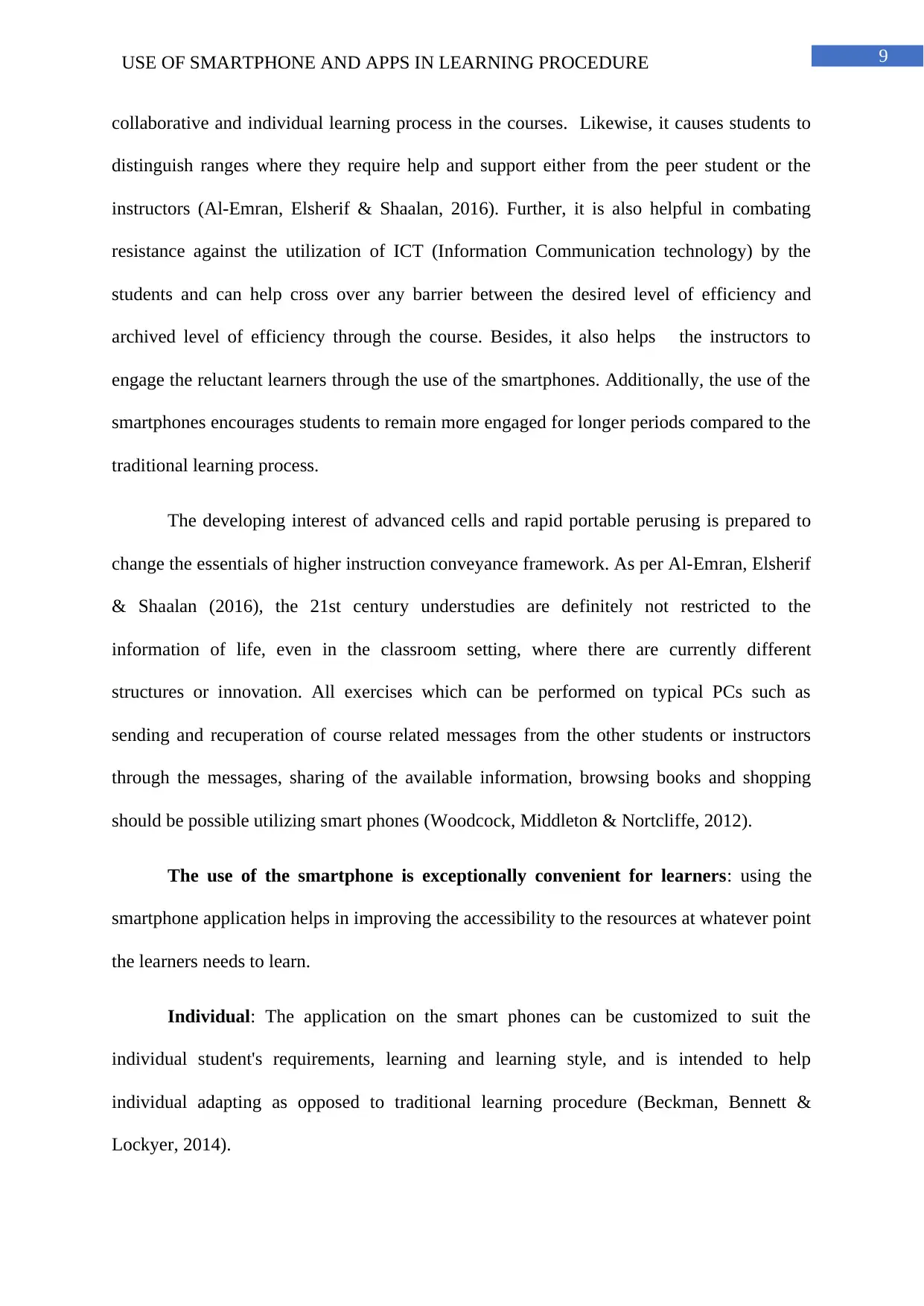
9USE OF SMARTPHONE AND APPS IN LEARNING PROCEDURE
collaborative and individual learning process in the courses. Likewise, it causes students to
distinguish ranges where they require help and support either from the peer student or the
instructors (Al-Emran, Elsherif & Shaalan, 2016). Further, it is also helpful in combating
resistance against the utilization of ICT (Information Communication technology) by the
students and can help cross over any barrier between the desired level of efficiency and
archived level of efficiency through the course. Besides, it also helps the instructors to
engage the reluctant learners through the use of the smartphones. Additionally, the use of the
smartphones encourages students to remain more engaged for longer periods compared to the
traditional learning process.
The developing interest of advanced cells and rapid portable perusing is prepared to
change the essentials of higher instruction conveyance framework. As per Al-Emran, Elsherif
& Shaalan (2016), the 21st century understudies are definitely not restricted to the
information of life, even in the classroom setting, where there are currently different
structures or innovation. All exercises which can be performed on typical PCs such as
sending and recuperation of course related messages from the other students or instructors
through the messages, sharing of the available information, browsing books and shopping
should be possible utilizing smart phones (Woodcock, Middleton & Nortcliffe, 2012).
The use of the smartphone is exceptionally convenient for learners: using the
smartphone application helps in improving the accessibility to the resources at whatever point
the learners needs to learn.
Individual: The application on the smart phones can be customized to suit the
individual student's requirements, learning and learning style, and is intended to help
individual adapting as opposed to traditional learning procedure (Beckman, Bennett &
Lockyer, 2014).
collaborative and individual learning process in the courses. Likewise, it causes students to
distinguish ranges where they require help and support either from the peer student or the
instructors (Al-Emran, Elsherif & Shaalan, 2016). Further, it is also helpful in combating
resistance against the utilization of ICT (Information Communication technology) by the
students and can help cross over any barrier between the desired level of efficiency and
archived level of efficiency through the course. Besides, it also helps the instructors to
engage the reluctant learners through the use of the smartphones. Additionally, the use of the
smartphones encourages students to remain more engaged for longer periods compared to the
traditional learning process.
The developing interest of advanced cells and rapid portable perusing is prepared to
change the essentials of higher instruction conveyance framework. As per Al-Emran, Elsherif
& Shaalan (2016), the 21st century understudies are definitely not restricted to the
information of life, even in the classroom setting, where there are currently different
structures or innovation. All exercises which can be performed on typical PCs such as
sending and recuperation of course related messages from the other students or instructors
through the messages, sharing of the available information, browsing books and shopping
should be possible utilizing smart phones (Woodcock, Middleton & Nortcliffe, 2012).
The use of the smartphone is exceptionally convenient for learners: using the
smartphone application helps in improving the accessibility to the resources at whatever point
the learners needs to learn.
Individual: The application on the smart phones can be customized to suit the
individual student's requirements, learning and learning style, and is intended to help
individual adapting as opposed to traditional learning procedure (Beckman, Bennett &
Lockyer, 2014).
Paraphrase This Document
Need a fresh take? Get an instant paraphrase of this document with our AI Paraphraser
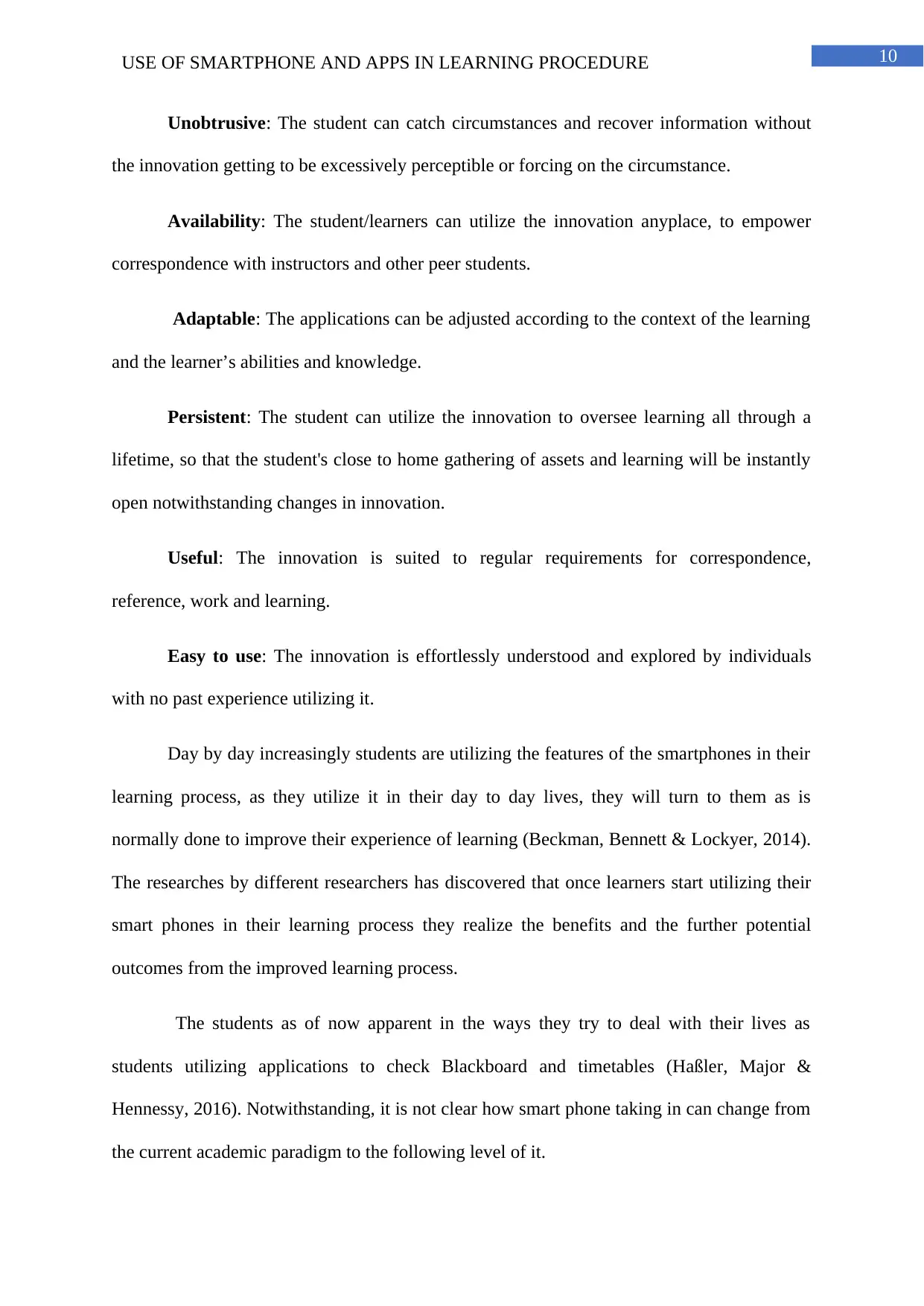
10USE OF SMARTPHONE AND APPS IN LEARNING PROCEDURE
Unobtrusive: The student can catch circumstances and recover information without
the innovation getting to be excessively perceptible or forcing on the circumstance.
Availability: The student/learners can utilize the innovation anyplace, to empower
correspondence with instructors and other peer students.
Adaptable: The applications can be adjusted according to the context of the learning
and the learner’s abilities and knowledge.
Persistent: The student can utilize the innovation to oversee learning all through a
lifetime, so that the student's close to home gathering of assets and learning will be instantly
open notwithstanding changes in innovation.
Useful: The innovation is suited to regular requirements for correspondence,
reference, work and learning.
Easy to use: The innovation is effortlessly understood and explored by individuals
with no past experience utilizing it.
Day by day increasingly students are utilizing the features of the smartphones in their
learning process, as they utilize it in their day to day lives, they will turn to them as is
normally done to improve their experience of learning (Beckman, Bennett & Lockyer, 2014).
The researches by different researchers has discovered that once learners start utilizing their
smart phones in their learning process they realize the benefits and the further potential
outcomes from the improved learning process.
The students as of now apparent in the ways they try to deal with their lives as
students utilizing applications to check Blackboard and timetables (Haßler, Major &
Hennessy, 2016). Notwithstanding, it is not clear how smart phone taking in can change from
the current academic paradigm to the following level of it.
Unobtrusive: The student can catch circumstances and recover information without
the innovation getting to be excessively perceptible or forcing on the circumstance.
Availability: The student/learners can utilize the innovation anyplace, to empower
correspondence with instructors and other peer students.
Adaptable: The applications can be adjusted according to the context of the learning
and the learner’s abilities and knowledge.
Persistent: The student can utilize the innovation to oversee learning all through a
lifetime, so that the student's close to home gathering of assets and learning will be instantly
open notwithstanding changes in innovation.
Useful: The innovation is suited to regular requirements for correspondence,
reference, work and learning.
Easy to use: The innovation is effortlessly understood and explored by individuals
with no past experience utilizing it.
Day by day increasingly students are utilizing the features of the smartphones in their
learning process, as they utilize it in their day to day lives, they will turn to them as is
normally done to improve their experience of learning (Beckman, Bennett & Lockyer, 2014).
The researches by different researchers has discovered that once learners start utilizing their
smart phones in their learning process they realize the benefits and the further potential
outcomes from the improved learning process.
The students as of now apparent in the ways they try to deal with their lives as
students utilizing applications to check Blackboard and timetables (Haßler, Major &
Hennessy, 2016). Notwithstanding, it is not clear how smart phone taking in can change from
the current academic paradigm to the following level of it.
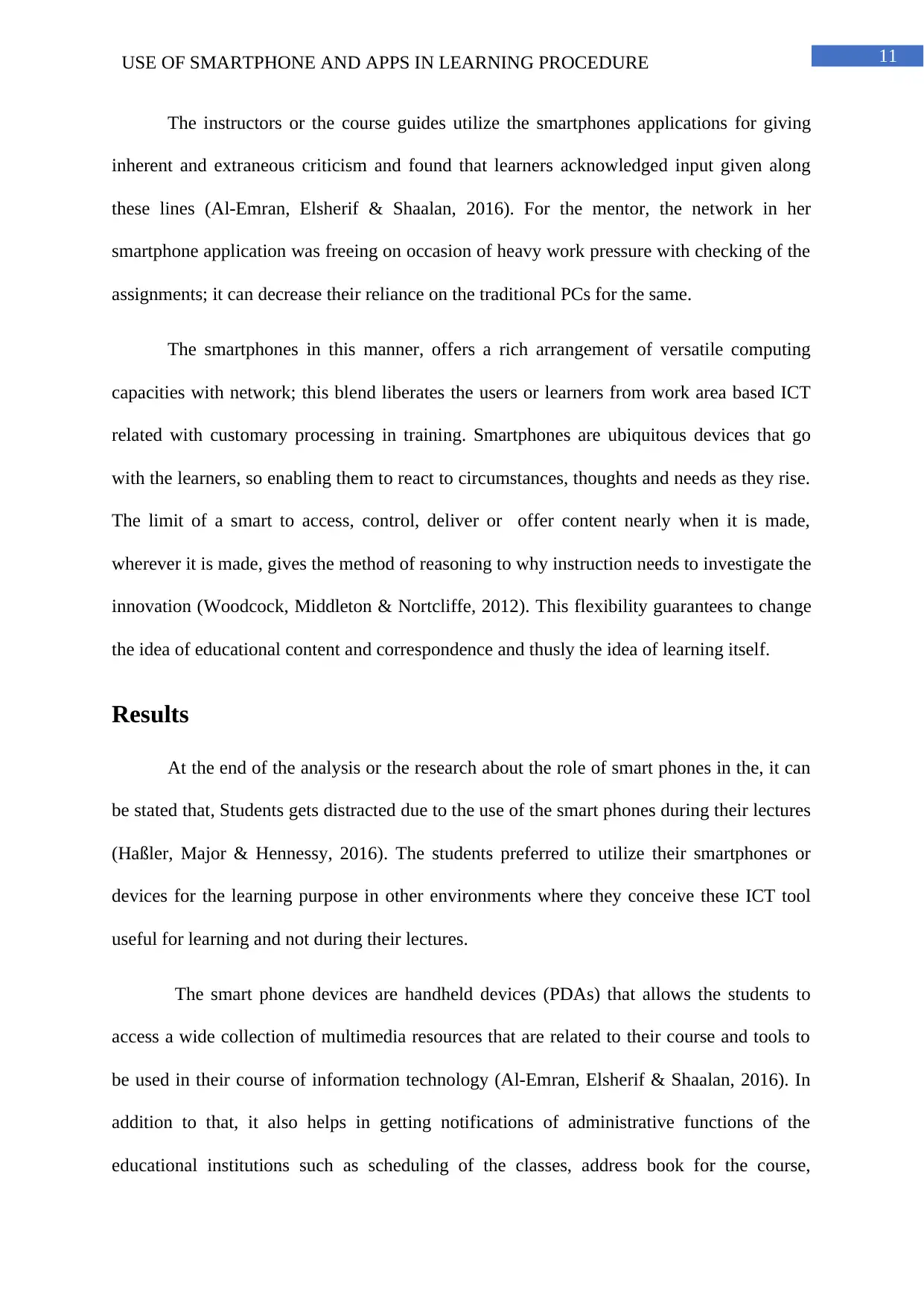
11USE OF SMARTPHONE AND APPS IN LEARNING PROCEDURE
The instructors or the course guides utilize the smartphones applications for giving
inherent and extraneous criticism and found that learners acknowledged input given along
these lines (Al-Emran, Elsherif & Shaalan, 2016). For the mentor, the network in her
smartphone application was freeing on occasion of heavy work pressure with checking of the
assignments; it can decrease their reliance on the traditional PCs for the same.
The smartphones in this manner, offers a rich arrangement of versatile computing
capacities with network; this blend liberates the users or learners from work area based ICT
related with customary processing in training. Smartphones are ubiquitous devices that go
with the learners, so enabling them to react to circumstances, thoughts and needs as they rise.
The limit of a smart to access, control, deliver or offer content nearly when it is made,
wherever it is made, gives the method of reasoning to why instruction needs to investigate the
innovation (Woodcock, Middleton & Nortcliffe, 2012). This flexibility guarantees to change
the idea of educational content and correspondence and thusly the idea of learning itself.
Results
At the end of the analysis or the research about the role of smart phones in the, it can
be stated that, Students gets distracted due to the use of the smart phones during their lectures
(Haßler, Major & Hennessy, 2016). The students preferred to utilize their smartphones or
devices for the learning purpose in other environments where they conceive these ICT tool
useful for learning and not during their lectures.
The smart phone devices are handheld devices (PDAs) that allows the students to
access a wide collection of multimedia resources that are related to their course and tools to
be used in their course of information technology (Al-Emran, Elsherif & Shaalan, 2016). In
addition to that, it also helps in getting notifications of administrative functions of the
educational institutions such as scheduling of the classes, address book for the course,
The instructors or the course guides utilize the smartphones applications for giving
inherent and extraneous criticism and found that learners acknowledged input given along
these lines (Al-Emran, Elsherif & Shaalan, 2016). For the mentor, the network in her
smartphone application was freeing on occasion of heavy work pressure with checking of the
assignments; it can decrease their reliance on the traditional PCs for the same.
The smartphones in this manner, offers a rich arrangement of versatile computing
capacities with network; this blend liberates the users or learners from work area based ICT
related with customary processing in training. Smartphones are ubiquitous devices that go
with the learners, so enabling them to react to circumstances, thoughts and needs as they rise.
The limit of a smart to access, control, deliver or offer content nearly when it is made,
wherever it is made, gives the method of reasoning to why instruction needs to investigate the
innovation (Woodcock, Middleton & Nortcliffe, 2012). This flexibility guarantees to change
the idea of educational content and correspondence and thusly the idea of learning itself.
Results
At the end of the analysis or the research about the role of smart phones in the, it can
be stated that, Students gets distracted due to the use of the smart phones during their lectures
(Haßler, Major & Hennessy, 2016). The students preferred to utilize their smartphones or
devices for the learning purpose in other environments where they conceive these ICT tool
useful for learning and not during their lectures.
The smart phone devices are handheld devices (PDAs) that allows the students to
access a wide collection of multimedia resources that are related to their course and tools to
be used in their course of information technology (Al-Emran, Elsherif & Shaalan, 2016). In
addition to that, it also helps in getting notifications of administrative functions of the
educational institutions such as scheduling of the classes, address book for the course,
⊘ This is a preview!⊘
Do you want full access?
Subscribe today to unlock all pages.

Trusted by 1+ million students worldwide
1 out of 22
Related Documents
Your All-in-One AI-Powered Toolkit for Academic Success.
+13062052269
info@desklib.com
Available 24*7 on WhatsApp / Email
![[object Object]](/_next/static/media/star-bottom.7253800d.svg)
Unlock your academic potential
Copyright © 2020–2025 A2Z Services. All Rights Reserved. Developed and managed by ZUCOL.





